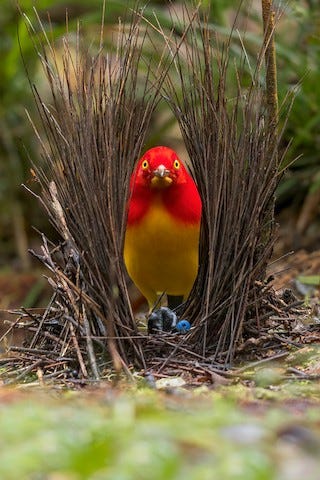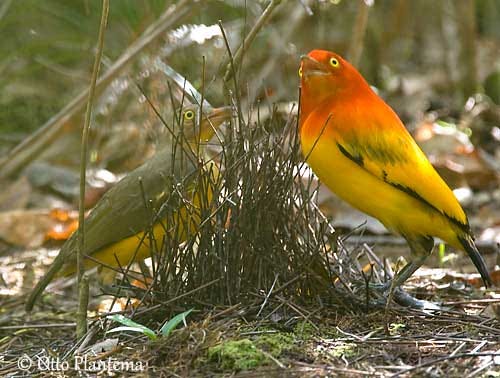Today’s gif header is taken from a BBC Earth Life Story documentary The Bowerbird's Grand Performance! And what a grand performance it is. He will expand and contract his wings and alternate the size and color of his pupils in an attempt to hypnotize his new friend. However, you shall have to watch to see if this male’s dance is impressive enough for this particular lady bowerbird.
Flame bowerbirds (Sericulus ardens) are endemic to the lowland and foothill forests in southern New Guinea. Like most bowerbirds, the male flame bowerbird builds elaborate nest-like bowers and undertakes showy displays in the hopes of attracting a mate. He will spend hours erecting the structure and will then decorate it with a variety of objects such as shells, flowers, feathers or fruit. Depending on the genus, a bowerbird might also collect discarded or stolen human-fabricated items such as bottlecaps, colorful plastic scraps or even children’s toys.
Male flame bowerbirds build what is known as an “avenue-bower” on the forest floor. This will be a small, neat structure made of short sticks surrounding a viewing vantage or avenue. Unlike some of his bowerbird cousins, flame bowerbirds prefer not to overload on the decorations, typically choosing a few blue, purple or brown fruits, purple and white flowers, mushrooms, snail shells and yellow leaves. When he deems everything with his bower just perfect, the male will call out to attract a female bowerbird to his staged scene. She may decide to stop by and watch his dance, and following the display she will either allow him to mate with her or she’ll judge the demonstration lacking and she’ll move on. Ladies’ choice!
If she is receptive, the pair will touch bills together inside the bower and later will mate. After copulation, the female will build a true nest to hold her eggs, typically laying two or three. Unlike the mating bower, the true nest will be saucer-shaped and situated high above the ground. The female flame bowerbird will incubate the eggs for 19-24 days and care for the chicks for about 50-56 days after hatching. The chicks typically fledge in about three weeks but the mother will continue to feed and care for them until they are fully independent. The male, on the other hand, will already be off to build more bowers in an attempt to attract more mates.
Sources and more information:
"Flame Bowerbird: Sericulus ardens, Passeriformes Order – Ptilonorhynchidae Family," Oiseaux-birds
"Bowerbirds: Meet the Bird World’s Kleptomaniac Love Architects" on Cool Green Science





Wow! That trick with the pupils is wild!
I'm ready to sleep with him.